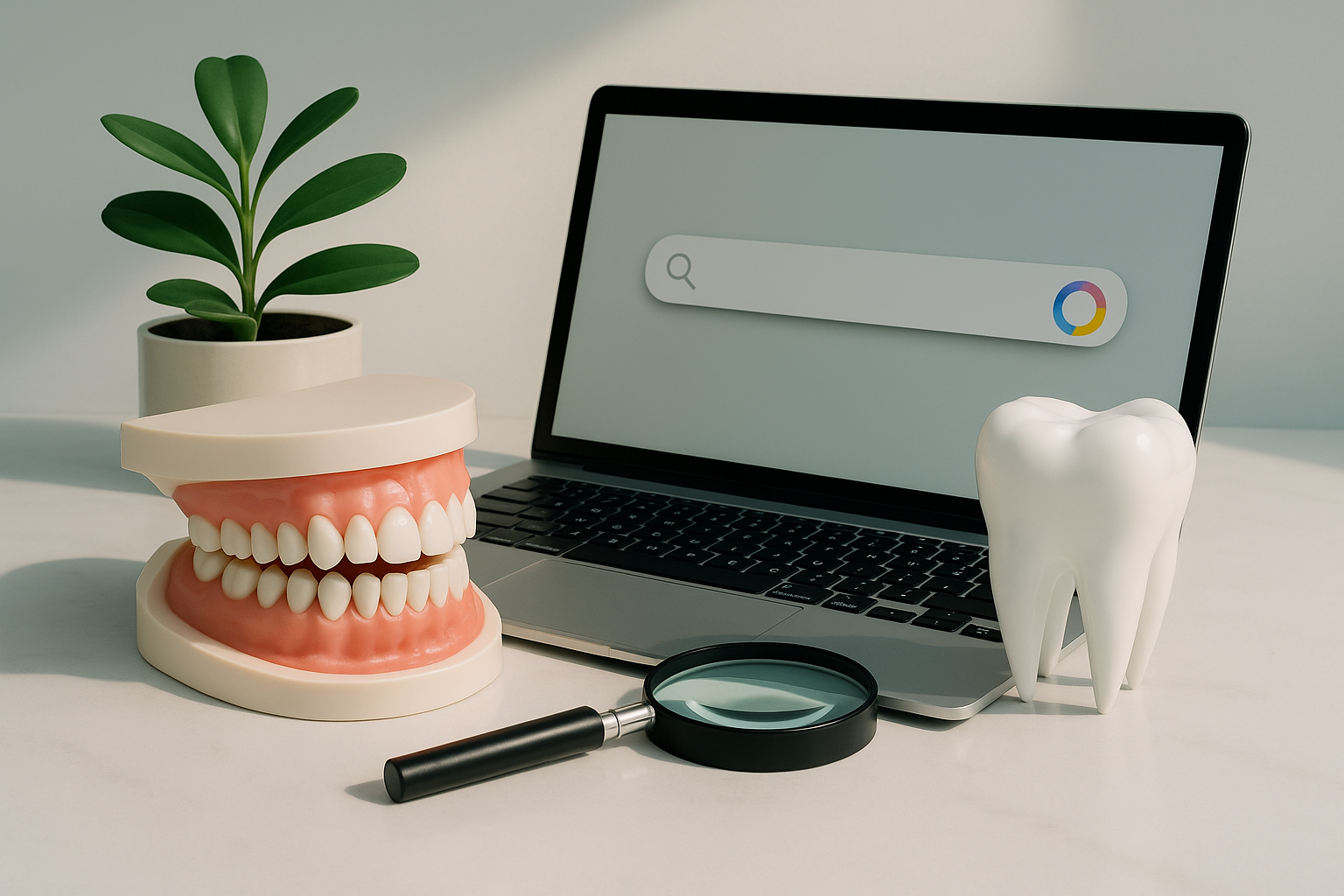Why Google Ads Are Failing Dental Practices in 2025 (And What SGE Means for Your Marketing)
If you’re seeing your Google Ads cost per click steadily climbing while your new patient numbers are flat, you’re not alone. Those expensive Google Ads are becoming increasingly irrelevant.
The reason isn't competition or seasonality. It's Google's new Search Generative Experience, and it's changing how patients find dental care. Most practices don't even know SGE exists, but it's already determining which dentists get recommended and which ones get buried — regardless of how much they spend on ads.
As a practicing dentist and marketing strategist for over two decades, I've seen every major shift in patient acquisition. What's happening with SGE now is the kind of change we haven’t seen since Google first launched AdWords. Is your dental practice ready?
What Is Google's Search Generative Experience?
SGE stands for Search Generative Experience — it's Google's new AI-powered search feature that changes how search results appear. Instead of showing just a list of blue links like traditional Google search, SGE uses generative AI to give users summarized answers at the top of the search page.
When someone searches for "best dental implant dentist near me," SGE pulls content from websites, social media platforms like Instagram, and other trusted sources to build comprehensive responses. It then presents this information as an AI-generated summary before showing any traditional search results or ads.
From my testing with various dental-related searches, SGE appears for the majority of dental service queries. This means most potential patients now see AI-generated recommendations before they ever see your Google Ads or even traditional search results.
Do Google Ads Appear in SGE Results?
This is where the problem becomes clear for practices relying heavily on paid search: SGE does not include paid ads in these AI summaries. The AI-generated responses pull exclusively from organic content — your website, your social media posts, your educational content, and your patient testimonials.
This means if your practice relies mostly on paid search, you might get buried beneath AI-generated recommendations that highlight your competitors who've invested in content creation and multi-platform presence.
I've watched this play out in real-time with practices in competitive markets. The dentists getting recommended in SGE results aren't necessarily spending the most on ads — they're the ones who've built comprehensive digital presences that AI systems can easily understand and recommend.
Why Are Dental Practice Google Ads Becoming Less Effective?
The rising cost of Google Ads for dental practices isn't just about increased competition — it's about decreased effectiveness. When SGE dominates the top of search results, traditional ads get pushed further down the page where fewer users ever see them.
I've been tracking this trend across multiple markets, and the pattern is consistent. Practices that built their patient acquisition primarily around Google Ads are seeing declining returns, while practices with strong organic content presence are maintaining or increasing their new patient numbers without increasing ad spend.
In fact, at Digital Floss we’re seeing clients get more new patients in the door without spending money on Google Ads. Their practices appear consistently in SGE results because we've built their content presence across multiple platforms.
SGE changes user behavior. When patients get comprehensive answers from AI-generated summaries, they're less likely to scroll down to click on ads. They're more likely to contact the practices that SGE specifically mentions in its recommendations.
How Can Dental Practices Appear in SGE Summaries?
Getting recommended in SGE requires a completely different approach than traditional SEO or paid advertising. SGE prioritizes practices with authentic, educational content that directly answers patient questions across multiple platforms.
The practices showing up consistently in SGE results have several things in common:
They maintain active social media presence, particularly on Instagram, which Google now indexes for search.
They create educational video content that explains procedures and addresses patient concerns.
They have websites with above-the-fold video content and comprehensive service information.
Most importantly, they maintain consistency across all platforms.
When SGE evaluates your practice, it's looking at your complete digital footprint. If your Instagram posts say one thing, your website another, and your LinkedIn profile something different, AI systems interpret this as a lack of credibility.
What Type of Content Does SGE Prioritize for Dental Practices?
Based on my analysis of SGE results across different dental markets, certain content types consistently appear in AI-generated summaries.
Educational content that answers specific patient questions performs exceptionally well. "What happens during dental implant surgery" or "How to prepare for Invisalign treatment" are the types of topics that SGE frequently pulls from practice websites and social media.
Patient testimonials and case studies also appear regularly in SGE results, particularly when they include specific details about treatment experiences and outcomes. SGE seems to value authentic patient voices over promotional content.
Behind-the-scenes practice content that showcases your team, technology, and approach to patient care helps establish credibility with AI systems. This type of content signals to SGE that you're a legitimate, active practice rather than just a marketing front.
Location-specific content performs particularly well for local dental searches. Instead of generic posts about oral health, create content tied to your community: "Why Plano families choose ceramic crowns over traditional options" or "Common dental concerns we see in Fort Worth patients."
How Do Instagram Posts Impact SGE Rankings?
The Instagram indexing update in July 2025 created a direct connection between your Instagram content and SGE results. Your Instagram posts now appear in regular Google search results, and SGE frequently pulls from Instagram content when making dental practice recommendations.
This means your Instagram captions need to be written strategically. You need to create content that answers patient questions and includes location-specific and service-specific terms. Use hashtags like #PlanoCosmticDentist or #FortWorthDentalImplants, and always tag your location.
What Should Dental Practices Do Instead of Relying on Google Ads?
The solution isn't to eliminate Google Ads entirely — it's to build the organic content foundation that SGE requires while using ads strategically for specific purposes. The practices thriving in this new environment understand that sustainable patient acquisition requires both immediate visibility and long-term authority building.
Focus your content creation on platforms that SGE scans: your website, Instagram, YouTube, and LinkedIn. Create educational video content that addresses common patient concerns and showcases your expertise. Maintain consistent messaging across all platforms that clearly communicates your location, services, and approach to patient care.
Use Google Ads strategically for high-intent searches like "dentist near me" or "emergency dental care" where immediate response matters more than educational content. But invest the majority of your marketing resources in building the organic presence that SGE rewards.
The practices making this transition successfully are seeing remarkable results. They're spending less on advertising while attracting higher-quality patients who've already been educated about their services through SGE recommendations.
When Will SGE Fully Impact Dental Practice Marketing?
SGE is already impacting how patients find dental care, but most practices haven't noticed because the change has been gradual. But from experience, I can tell you that practices that wait to adapt will find themselves increasingly invisible as SGE becomes the default way patients research dental services.
Start auditing your SGE visibility immediately. Search for your services in your area and see whether your practice appears in the AI-generated summaries. If you're not appearing, your competitors who are building comprehensive content strategies are claiming that visibility.
The practices that started building their SGE presence six months ago now have significant advantages. They appear consistently in AI-generated recommendations, they're attracting patients who've already been educated about their services, and they're spending less on paid advertising while seeing better results.
At Digital Floss, we've been preparing our clients for the SGE reality, and the results speak for themselves. Our clients are showing up at the top of AI-generated search results while their competitors remain invisible, regardless of how much those competitors spend on traditional advertising.
About Dr. Anissa Broussard
Dr. Anissa Broussard is a dentist with over 20 years of clinical experience and dentistry's leading digital marketing expert. She is the co-founder of Digital Floss, a full-service dental marketing agency specializing in AI-optimized strategies for dental practices, and DentalFlix, the premier online education platform for dental practice training. Named one of the Top 25 Women in Dentistry, she was the first in the dental industry to discover how sales funnels can work in dental practices.
Dr. Broussard was recruited by ClickFunnels to create the Brick and Mortar Funnel Framework and holds a Fellowship with the Dental Speaking Institute. She has keynoted at major events including the AACD, Social Media Marketing World, and Funnel Hacking Live.












